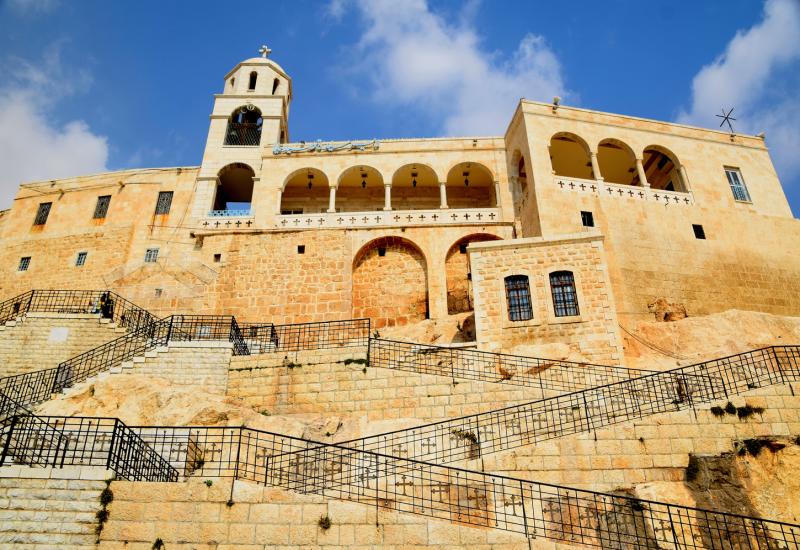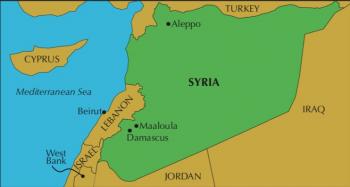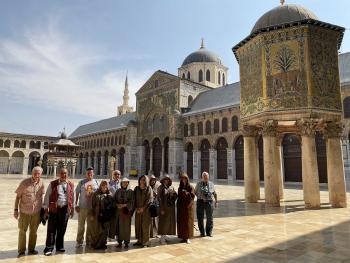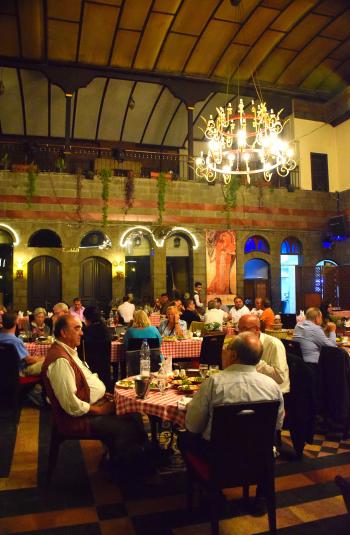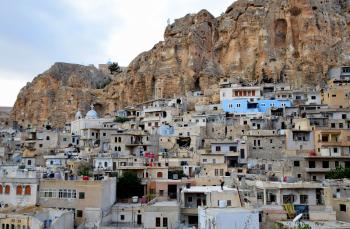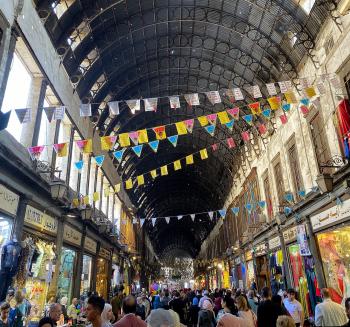Visiting Syria – an extraordinary opportunity
This article appears on page 6 of the July 2020 issue.
As part of the first group of American tourists to be admitted to the country since the civil war began in 2011, I traveled by land with 10 other guests from Beirut, Lebanon, to Syria on Oct. 20, 2019, in what was to prove to be an extraordinary adventure. The trip was arranged by Spiekermann Travel Services (Eastpointe, MI; 800/645-3233, mideasttrvl.com).
I had no idea how (or if) we were going to reach Damascus because nationwide antigovernment protests had just broken out throughout Lebanon, and there were road blockages everywhere, but I had faith that Spiekermann would find a way to make this trip happen. The company is masterful at workarounds.
A rough start
At 5 a.m., the 11 of us boarded a small bus, departing from our lovely and very-well-located Beirut hotel, the Raouché Arjaan by Rotana — situated right on the Mediterranean, with a beautiful view of the Raouché Rocks — for what should have been, under normal conditions, a less-than-three-hour trip to Damascus. The trip took us nearly six hours.
We had hoped that, by traveling at that early hour, we would avoid the road blockages. Instead, we encountered multiple barriers along the way, consisting of burning tires, stones and/or heaps of trash piled onto the roads and guarded by protesters who refused to let traffic through.
Our driver, accompanied by our local guide, Pauline, never gave up trying to find a way through. Working together, they always managed to find an open route.
We finally arrived at Lebanon’s eastern border at 7:25 a.m. and got off our bus to go to the Lebanese guard/Immigration station. We were stamped out of Lebanon at 7:45.
Note: We changed Lebanese money for Syrian money there, and we received as fair a rate as we were going to get thanks to Antoine, our local Syrian guide, who said money-changers elsewhere were known to give out counterfeit money. We were told to change $50, but that was probably too much, as US dollars were gratefully accepted everywhere.
After clearing Customs at 8:10 and passing through multiple additional checkpoints, we proceeded through the no-man’s-land between the two countries on a different bus, crossing a distance of at least 5 miles. At 8:20, we reached the Syrian border.
We had expected the Immigration process to go smoothly because all of us had received visas and permits to travel to designated areas of Syria. However, one person in our group was rejected by Syrian Immigration because this guest had a Jordanian passport stamp that the Immigration officials claimed could only have been obtained if the guest had been coming from Israel across the Allenby Bridge into Jordan, something the guest denied.
Antoine tried everything he could to change their minds, but it was not to be. This guest was in no way mistreated but did have to leave the group and return to Lebanon. Arrangements were made by Antoine and Ghiath, our tour leader, for the guest’s return journey to Beirut.
It was shocking and very sad for everyone, particularly because Syria was the last of the 193 official countries of the world (according to the UN) that this guest needed to complete the list. None of us, including our Syrian tour leaders, could figure out the reason for the rejection, given the Syrian government’s prior approval of this guest’s visit.
At 9:50, with passports back in hand, we had to wait once more before going through a few additional checkpoints. Finally, at 10 a.m., our group proceeded on to the Ancient City area of Damascus.
Safe in Syria
The road to the Ancient City was a wide, divided highway in excellent condition. Ghiath assured us that everything was safe in Damascus, and so it was.
Passing through even more checkpoints en route to the city, we stopped at one where a soldier wearing a Puma-brand cap boarded our bus and walked to the back without explanation. He then walked back up to the front of the bus, picked up the microphone and said, in English, “Welcome to Syria!”, giving us a big smile and a thumbs-up. We all applauded!
Along the way into town we passed through the “Beverly Hills” of Damascus, seeing huge mansions and modern apartment complexes. In addition to the substantial urban sprawl on the outskirts of the city, there was terraced farmland.
In heavy traffic, we arrived in Damascus at 10:45. The main road into town was eight lanes wide and in excellent condition. It was delightful to drive by the attractive, bustling Damascus University, filled with male and female students. Most but not all of the women wore hijab. (Foreign women are not required to wear any head or body covering, but dress must, of course, be modest.)
I was surprised to see so much green in Damascus — palm trees and areas of nicely mowed grass.
We passed by the huge, modern Opera House, the National Museum and the Four Seasons megahotel (now closed) on our way to the Ancient City. All of Damascus seemed peaceful and relaxed, with everyone simply going about their business. Arriving at last, we left our bus in front of the 11th-century Citadel of Damascus.
As soon as I’d left the bus, a woman, dressed in hijab and abaya, approached me and asked where our group was from. I told her we were visiting from the USA. Upon hearing this news, she threw her arms around me and kissed me before we took some “selfies” together.
This kind of warm greeting happened at other times throughout the trip.
Impressive sites
Our group walked along the huge original stone wall of the Citadel and then through Souk Al-Hamidiyah, a wonderful old structure with very high ceilings. The souk was bustling with shoppers and displayed tempting merchandise of all sorts.
Just outside, at the other end of the souk, which boasts some impressive ruins from a Roman temple, we saw Russian soldiers standing next to a small Russian tank.
Perhaps the most wonderful site in the Ancient City, at least for me, was the very first place we visited, the 8th-century Great Mosque of Damascus (Umayyad Mosque). One of the largest mosques in the world, it displays interior marble arches, chandeliers, lovely red carpeting and an exquisite mihrab (prayer niche) with mother-of-pearl inlays and overall tones of gray and (real) gold.
Inside the massive mosque was a large, elaborate shrine of John the Baptist, who is honored as a prophet by Muslims. But most phenomenal of all was the courtyard. There is nothing like it anywhere in the world!
The courtyard is gigantic, with elegant proportions and exquisitely carved marble columns, but what makes it so special are the early-8th-century mosaics depicting, in gold and 14 shades of green, scenes from Paradise, with gorgeous flowering trees, colonnaded palaces and a long, flowing river. These images are displayed along an entire wall.
Elsewhere in the courtyard are other spectacular structures, such as the Treasury, also bedecked with gorgeous gold mosaics, and a small but elegant fountain made principally of wood and marble. The entire courtyard is surrounded by a magnificent arcade, with delicately carved marble columns. Many of the columns’ capitals are Roman.
Our tour leaders made arrangements to allow our group to walk around the entire courtyard by ourselves — a real treat. This visit to the Great Mosque was worth a trip to Syria all by itself.
Note: At the mosque, women were required to be covered, head to toe. Brown garments were furnished inside the mosque for this purpose, free of charge. There were less-strict rules on clothing for men (no shorts or bare shoulders).
Adjacent to the Great Mosque is the 12th-century Mausoleum of Saladin. We saw two sarcophagi inside, one of which, fitted with a black covering embroidered with gold thread, is said to contain Ayyubid Sultan Saladin’s remains. The white, black and reddish-brown striped walls are embedded with beautiful blue and white mosaics.
Following our visit to the Great Mosque and Saladin’s Mausoleum, we had lunch at a fabulous restaurant, Jabri House, formerly part of a private home and still owned by the Jabri family. The unassuming entrance, along a narrow pedestrian street, gave way to a very impressive 3-story interior atrium replete with trees, hanging vines and a lovely central fountain.
Our lunch was delicious from start to finish.
In the afternoon we visited the Azem Palace (AD 1749), also in the Ancient City. This sublime Ottoman palace was formerly the home of the governor of Damascus.
The massive property is built around a lovely rectangular courtyard framed by a series of connecting buildings (except for the beautiful hammam, which is separate) that contain gilded and exquisitely painted rooms that today display rare objects such as musical instruments, intricately carved and inlaid furniture and brilliant blue and gold decorative glass objects.
The Damascene-style architecture was brilliantly portrayed throughout, with thoughtful little touches like scalloped and inlaid niches sheltering delicate bronze lanterns. The exterior walls were covered with complicated and complementary inlaid designs.
This palace, like the Great Mosque, is a world-class site.
After our visit, we walked through the charming spice-and-candy souk, then took a walk through the surrounding neighborhood, stopping in to see Ghiath’s beautiful townhouse, which he said has been featured from time to time in locally produced sitcoms. His house, a narrow, tall building with a lovely wooden ceiling, had a great view from the rooftop terrace overlooking part of the Ancient City.
We ended the day at our fabulous hotel, the atmospheric Beit Zaman, made up of four formerly private townhouses that were melded charmingly together and filled with impressive antiques. Its location in the Ancient City is unbeatable, and the rooms, service and food were all top-notch during my stay.
Dinner was at the Al-Adin Café & Restaurant nearby, featuring great food and a presentation of Syrian dancing.
More ancient sites
On our second day we stopped at Bab Kisan (Kisan Gate), one of the seven city gates of Old Damascus. When St. Paul was forced to flee the city under cover of night, legend has it that it was at Bab Kisan, built by the Romans, that he was lowered in a basket down from a window in the wall, a beautifully carved structure of gray stone.
From there we drove in heavy traffic to the National Museum of Damascus, Syria’s largest museum, covering the entire span of Syrian history, more than 11 millennia. The museum, whose façade is embedded with the intricately carved face of an Islamic palace, dates to 1919.
It is one of the finest museums in the world. Among the treasures it houses are the astounding, unique frescoes from the Dura-Europos Synagogue (AD 244), one of the oldest synagogues in the world, and the early-2nd-century Hypogeum of Yarhai, a Palmyra tomb extracted intact and considered to be one of the finest examples of Palmyrene funerary art.
This tomb consists of two rooms, with three huge stone sarcophagi lining the walls of one of them. The rest of the tomb features reliefs of members of the Yarhai family that fill almost every square inch of wall space.
The door of the tomb is made out of stone but carved to look like wood. In a word, the tomb is jaw-dropping.
There is insufficient space here to record the many astounding treasures in the National Museum. Visitors would be well advised to reserve a full day to visit it. Sadly, our schedule did not permit us that luxury.
We were soon headed out of Damascus toward the mountains, arriving midday at the Saidnaya Monastery. This complex sits on a hill and has a dramatic façade, with layers of steps leading up to its entrance. Inside is a lovely courtyard.
The inner walls of the building are covered with beautiful icons, and there is an attractive iconostasis in the main sanctuary.
Beauty and brutality
Our next stop was the town of Maaloula, situated on a rugged, rocky mountainside approximately 35 miles northeast of Damascus. After a surprise attack in 2013 by jihadist forces (the town was a target because it was a rich symbol of Christianity rather than because of any strategic value), many of Maaloula’s residents fled, leaving the town’s population drastically reduced. Virtually all of the buildings, or what is left of them, are pocked with gun and mortar holes — a grim reminder of the inhumanity of the attackers.
The reason for our visit was to see St. George’s Church, an old stone church that was heavily damaged but recently restored (although, tragically, it lost 100% of its beautiful icons, now displayed on the walls in the form of photographs). The church congregation members are speakers of the ancient Aramaic language, and we were extremely fortunate to hear the Lord’s Prayer sung and spoken in Aramaic by a female attendant.
We also visited the St. Thekla Monastery in a different part of town, where we had an unexpected meeting with one of the at least 12 nuns from the monastery who had been kidnapped by terrorists for three months before being freed in a prisoner exchange. The nun, in traditional black garb, calmly relayed to us some of her ordeal.
After our visit, we left the monastery and walked up through part of a narrow canyon close by. A local family picnicking there saw us and immediately came over to hug and kiss us, extending an immediate invitation to join them in their meal.
On our way back to Damascus, we passed through three checkpoints. As we drew closer to the city, we saw sprawling former residential areas that had been destroyed. Words are inadequate to describe the devastation.
After a brief rest at the hotel, our group walked down the street to the large, charming Al-Khair Palace Restaurant. There we were treated, again, to excellent food.
In addition, we had the pleasure of watching a wonderful performance by a Whirling Dervish (whom I met afterwards) as well as one by another man who also danced rapidly in tight circles but who was wearing two skirts, one over his shoulders and one over his hips, decorated all over with special lights that shone in the dark. It was quite a spectacular performance.
We checked out of the hotel the next morning and toured the modern area of Damascus by bus before driving on to the Syrian border. One of the guests had brought along a specially made little flag with the number “193” on it, denoting the completion of 193 official countries visited for the group member who had been denied entry earlier. Antoine worked some magic in negotiating with the Immigration official to allow all of us to stroll across to the “wrong” side of the road and pose for a photo in front of the “Syria” sign that we’d seen when we entered the country.
We departed Syria at 11:15 a.m., arriving back in Beirut at 3:20 p.m. after enduring multiple road blockages and workarounds all the way back.
This short Syria trip, offered as an extension to my Lebanon tour ($1,160 plus a $240 single supplement), was a truly extraordinary experience. I can’t wait to go back for a more extended visit.
Spiekermann Travel Services, which arranged my trip, is now offering extended trips to Syria that will include visits to some of the above-mentioned sites. Priced at $4,995 (per person, double, including airfare from New York), their next tour is scheduled for March 6-16, 2021.

